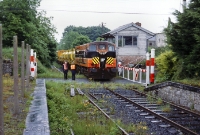Castletown
Castletown, Co.Westmeath, was a wayside station on the former Midland Great Western Railway's main line between Mullingar and Athlone, which opened in August 1851. Up to 1973, this line was used by all Galway and Mayo line trains, but these were re-routed via Portarlington from Great Southern & Western Railway's Heuston Station in Dublin. Thus the Mullingar to Athlone line became the poor relation to the main line to Galway and the west after this, with the last scheduled passenger service having traversed the route in 1987. The line remained in use however for frequent freight trains up to the late 1980s, and latterly specials and PWD workings until early 2000s.
Castletown itself lost its passenger service in 1963, but the station remained an important signalling blockpost and loop until May 1987. Today the disused up & down platforms remain, with the single storey MGWR station building nowadays being a private residence. The signal cabin is a retained as gatebox adjacent to the level crossing at the east end of the station. The derelict goods shed and associate loading bank also remains.
Castletown itself lost its passenger service in 1963, but the station remained an important signalling blockpost and loop until May 1987. Today the disused up & down platforms remain, with the single storey MGWR station building nowadays being a private residence. The signal cabin is a retained as gatebox adjacent to the level crossing at the east end of the station. The derelict goods shed and associate loading bank also remains.

























